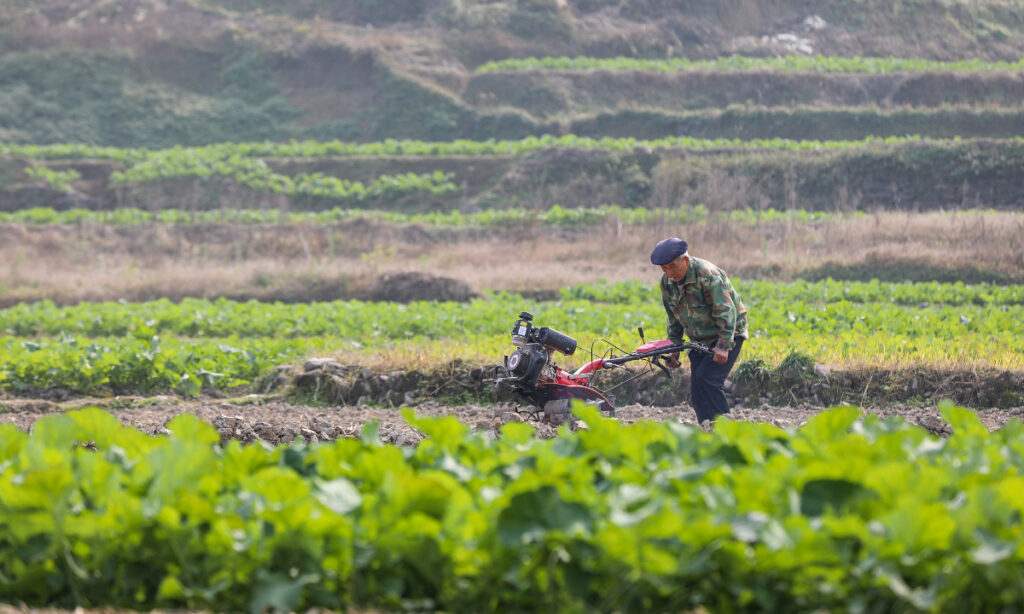With winter grain sowing across China completing over 99 percent, experts said on Saturday that the smooth sowing this season has laid a solid foundation for the harvest next year, ensuring nation’s food supply while facilitating economic growth despite the downward pressure.
The autumn and winter grain sowing across China is drawing to a close, with both seeding of winter wheat and oilseed rape exceeding 99 percent, data traced by the Ministry of Agriculture and Rural Affairs (MOA) showed on Saturday.
“We finished sowing by mid-October, generally the same time comparing to previous years,” Song Kun, a farmer in Huaibei, East China’s Anhui Province, told the Global Times. He planted 20 mu (1.33 hectares) of winter wheat this year.
Anhui is one of the major wheat producers in the country. Other main producers include Central China’s Henan, Hubei provinces, East China’s Shandong Province, as well as North China’s Shanxi and Northwest China’s Shaanxi Province.
Henan’s winter wheat planting area has been maintained around 85 million mu in the year. According to a report by the People’s Daily on Friday, more than 11.9 million mu of winter wheat has sprouted in Henan’s Zhumadian city. Given that there are more weed in the fields this year, farmers and technicians have been using large sprayers to weed so as to ensure the healthy growth of the plants.
This year’s winter wheat sprout is the best in recent years, the report said, citing Lü Xiutao, an official from MOA. Lü noted they will work on stabilizing the wheat planting area above 335 million mu and to strive for an output growth.
“Winter wheat is of great significance for ensuring food security, and the smooth sowing of winter grain has laid a solid foundation for the harvest in next summer season,” Li Guoxiang, a research fellow at the Rural Development Institute of the Chinese Academy of Social Sciences, told the Global Times on Saturday.
In spite of frequent extreme weathers and the COVID-19 pandemic in recent years, China has managed to see steadily increased grain production, with output stabilizing at more than 1.3 trillion jin (650 million tons) for seven consecutive years, and reaching a record high of 1.3657 trillion jin in 2021, according to data from the National Bureau of Statistics (NBS).
The steady growth continues in 2022, with the nation’s summer grain output hitting 294.8 billion jin, a record high, and an increase of 2.87 billion jin over the previous year, despite challenges like extended autumn flooding, the sporadic resurgence of COVID-19 and rising costs. And a bumper autumn harvest is well expected, as 98 percent of autumn grain nationwide has been harvested as of Saturday, according to MOA.
Against the backdrop of the complicated international situation exacerbated by the Ukraine crisis, the COVID-19 pandemic and other factors, China’s stable grain production is of great significance for the overall food security of the world, Li noted.
The world is on its way to “a raging food catastrophe,” UN Secretary-General António Guterres warned at the recent G20 summit in Indonesia. “Without coordinated action, this year’s crisis of affordability may become next year’s global food shortage,” he said.
Though China has only 9 percent of the world’s arable land and 6 percent of the freshwater resource, it has been capable of feeding one-fifth of the global population. In addition, China’s per capita grain supply hit 483 kilograms in 2021, higher than the internationally recognized safety line of 400 kilograms.
The steady growth of grain output does not only secure China’s food supply, but also plays a vital role in facilitating the economic recovery and growth amid the mounting downward pressure, Li said.
In the first three quarters of the year, the overall agricultural and rural economy maintained a sound momentum of development, with the added value of the primary industry coming in at 5.48 billion yuan, up by 4.2 percent year-on-year. It has provided solid support for ensuring people’s livelihoods, preventing inflation and stabilizing the economy, MOA said at a quarterly press conference on October 29.
In addition, the trade volume of the country’s agricultural products totaled $248.51 billion in the first nine months of 2022, up 10.4 percent year-on-year. Exports jumped 21.5 percent over the same period last year, while imports rose 6.4 percent, MOA data showed.
(Global Times)




